Last analysis expected upwards movement to continue towards a target at 1,320. Price did make a new high but was well short of the target.
Summary: The larger trend remains up but a pullback has finally arrived. At its end, it should offer an entry point to join the upwards trend. That may not be until the end of this week or the beginning of next week.
The target for the pullback to end is 1,278.
New updates to this analysis are in bold.
Last monthly charts for the main wave count are here, another monthly alternate is here, and video is here.
Grand SuperCycle analysis is here.
The wave counts will be labelled first and second. Classic technical analysis will be used to determine which wave count looks to be more likely. In terms of Elliott wave structure the second wave count has a better fit and fewer problems.
FIRST ELLIOTT WAVE COUNT
WEEKLY CHART
There are more than 23 possible corrective structures that B waves may take, and although cycle wave b still fits well at this stage as a triangle, it may still be another structure. This wave count looks at the possibility that it may be a double zigzag.
If cycle wave b is a double zigzag, then current upwards movement may be part of the second zigzag in the double, labelled primary wave Y.
The target remains the same.
Within intermediate wave (C), no second wave correction may move beyond the start of its first wave below 1,205.41. However, prior to invalidation, this wave count may be discarded if price breaks below the lower edge of the black Elliott channel. If this wave count is correct, then intermediate wave (C) should not break below the Elliott channel which contains the zigzag of primary wave Y upwards.
There are now three problems with this wave count which reduce its probability in terms of Elliott wave:
1. Cycle wave b is a double zigzag, but primary wave X within the double is deep and time consuming. While this is possible, it is much more common for X waves within double zigzags to be brief and shallow.
2. Intermediate wave (B) within the zigzag of primary wave Y is a double flat correction. These are extremely rare, even rarer than running flats. The rarity of this structure must further reduce the probability of this wave count.
3. Although intermediate wave (C) should be continuing so that primary wave Y ends substantially above the end of primary wave W, the duration and depth of minor wave 2 within it now looks to be too large at the weekly time frame.
DAILY CHART
The analysis will focus on the structure of intermediate wave (C). To see details of all the bull movement for this year see daily charts here.
Intermediate wave (C) must be a five wave structure, either an impulse or an ending diagonal. It is unfolding as the more common impulse.
It is possible that minor waves 1 and now 2 may both be over. Minor wave 2 may have ended very close to the 0.618 Fibonacci ratio. If it continues lower, then minor wave 2 may not move beyond the start of minor wave 1 below 1,205.41.
Minor wave 1 lasted 44 days and minor wave 2 may have lasted 20 days, just one short of a Fibonacci 21.
It is of some concern now that minor wave 3 appears to be starting out rather slowly. This is somewhat unusual for a third wave and offers some support now to the second Elliott wave count. With StockCharts data showing a steady decline in volume as price rises, this concern is now validated.
HOURLY CHART
If a five up is complete, then a three down should follow. The most likely target for minute wave ii would be the 0.618 Fibonacci ratio of minute wave i, but it may not be low enough if this target is wrong. The first second wave correction within a new trend is commonly very deep for Gold.
Minute wave ii may not move beyond the start of minute wave i below 1,260.72.
There is more than one way to see the subdivisions within minute wave i upwards; this chart is only one way. What does look clear today is that downwards movement has broken below a channel drawn which contains prior upwards movement. This downwards movement today looks very much like a new wave, separate to the upwards wave labelled minute wave i.
If upwards movement was a five, then downwards movement should be a three and may not move beyond the start of the five up for minute wave i.
Minute wave i would have lasted six days (not a Fibonacci number). Minute wave ii may be initially expected to total a Fibonacci three days, minimum, but more likely will last a Fibonacci five or eight days.
Minute wave ii would most likely be a zigzag, but it may be any other corrective structure except a triangle.
So far it looks like a quick five down may have ended at today’s low. This may be minuette wave (a) of a zigzag for minute wave ii. If this is correctly labelled as a five, then minuette wave (b) may not move beyond its start above 1,305.70.
SECOND ELLIOTT WAVE COUNT
WEEKLY CHART
It is still possible that cycle wave b is unfolding as a regular contracting or barrier triangle.
Within a triangle, one sub-wave should be a more complicated multiple, which may be primary wave C. This is the most common sub-wave of the triangle to subdivide into a multiple.
Intermediate wave (Y) now looks like a complete zigzag at the weekly chart level.
Primary wave D of a contracting triangle may not move beyond the end of primary wave B below 1,123.08. Contracting triangles are the most common variety.
Primary wave D of a barrier triangle should end about the same level as primary wave B at 1,123.08, so that the B-D trend line remains essentially flat. This involves some subjectivity; price may move slightly below 1,123.08 and the triangle wave count may remain valid. This is the only Elliott wave rule which is not black and white.
Finally, primary wave E of a contracting or barrier triangle may not move beyond the end of primary wave C above 1,295.65. Primary wave E would most likely fall short of the A-C trend line. But if it does not end there, then it can slightly overshoot that trend line.
Primary wave A lasted 31 weeks, primary wave B lasted 23 weeks, and primary wave C lasted 38 weeks.
The A-C trend line now has too weak a slope. At this stage, this is now a problem for this wave count, the upper A-C trend line no longer has such a typical look.
Within primary wave D, no part of the zigzag may move beyond its start above 1,357.09.
DAILY CHART
This second wave count expects the new wave down may be deeper and longer lasting than the first wave count allows for.
A common length for triangle sub-waves is from 0.8 to 0.85 the length of the prior wave. Primary wave D would reach this range from 1,170 to 1,158.
If primary wave C is correctly labelled as a double zigzag, then primary wave D must be a single zigzag.
Within the single zigzag of primary wave D, intermediate wave (A) is labelled as a complete impulse.
Intermediate wave (A) lasted 20 days, just one short of a Fibonacci 21. Intermediate wave (B) may be about the same duration, so that this wave count has good proportions, or it may be longer because B waves tend to be more complicated and time consuming.
Intermediate wave (B) may be a sharp upwards zigzag, or it may be a choppy overlapping consolidation as a flat, triangle or combination. At this stage, it looks most likely to be incomplete because an intermediate degree wave should last weeks. At its conclusion intermediate wave (B) should have an obvious three wave look to it here on the daily chart.
HOURLY CHART
It is possible to see the last wave up, which for this second wave count is labelled minor wave A, as a three wave structure. It is also possible to see it as a five in the same way as the first hourly chart sees its subdivisions.
If minor wave A is a three wave zigzag, then intermediate wave (B) may be unfolding as a flat, triangle or combination.
When A waves subdivide as threes, the following B wave is normally very deep indeed and may make a new price extreme beyond the start of wave A as in an expanded flat, running triangle or combination.
At this stage, if downwards movement makes a new low below 1,260.72 in the next week or so, this second wave count would be strongly indicated.
For the short term, both wave counts see downwards movement for Monday’s session as a completed five. A bounce should follow, and it may find resistance about the lower edge of the best fit channel that contains prior upwards movement.
TECHNICAL ANALYSIS
WEEKLY CHART
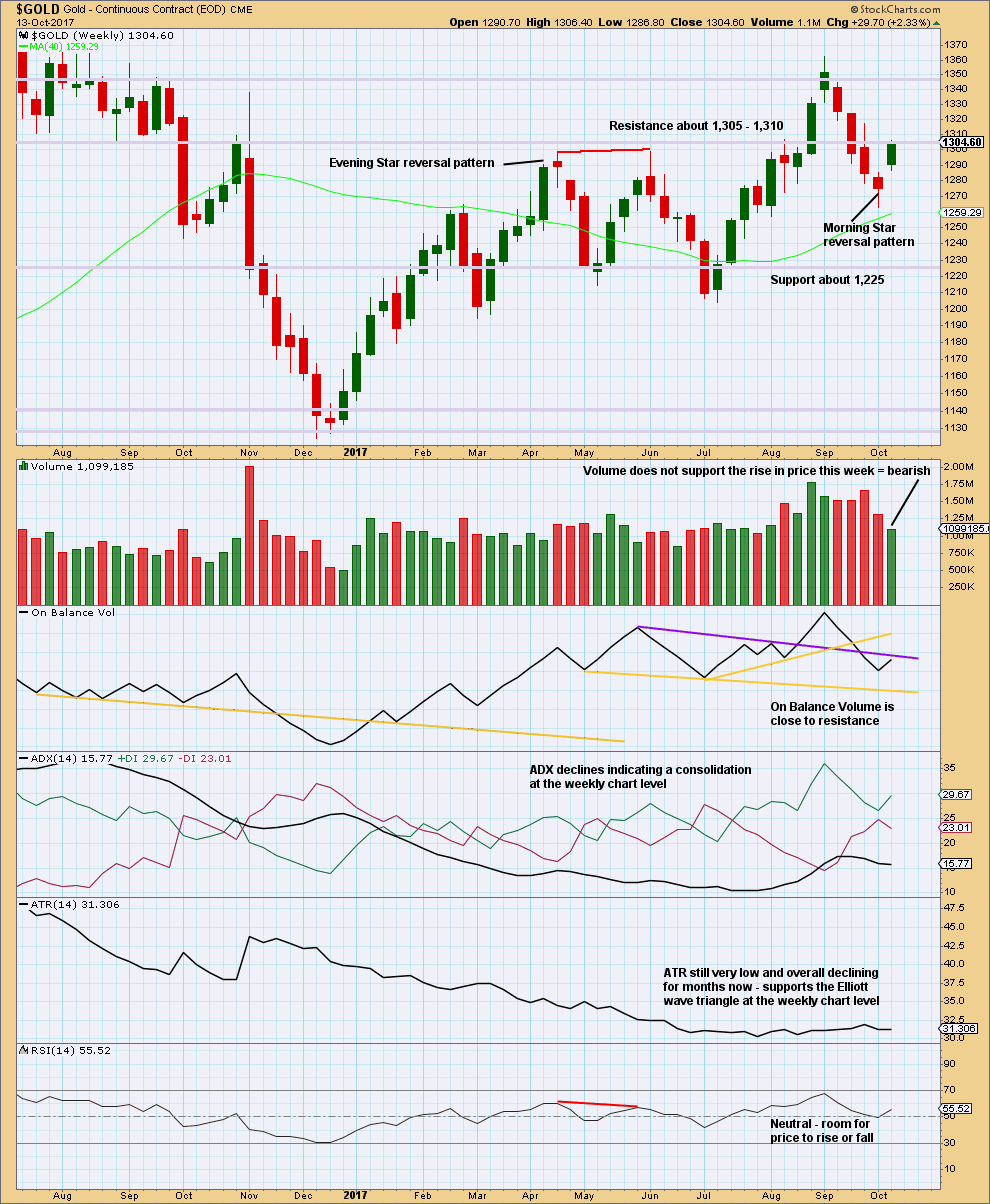
Click chart to enlarge. Chart courtesy of StockCharts.com.
This last weekly candlestick completes a Morning Star reversal pattern, which is bullish.
Without support from volume for upwards movement though, it should be suspicious. The reversal pattern may signify a new sideways trend or a short lived upwards bounce.
Resistance at On Balance Volume may halt the rise in price.
DAILY CHART
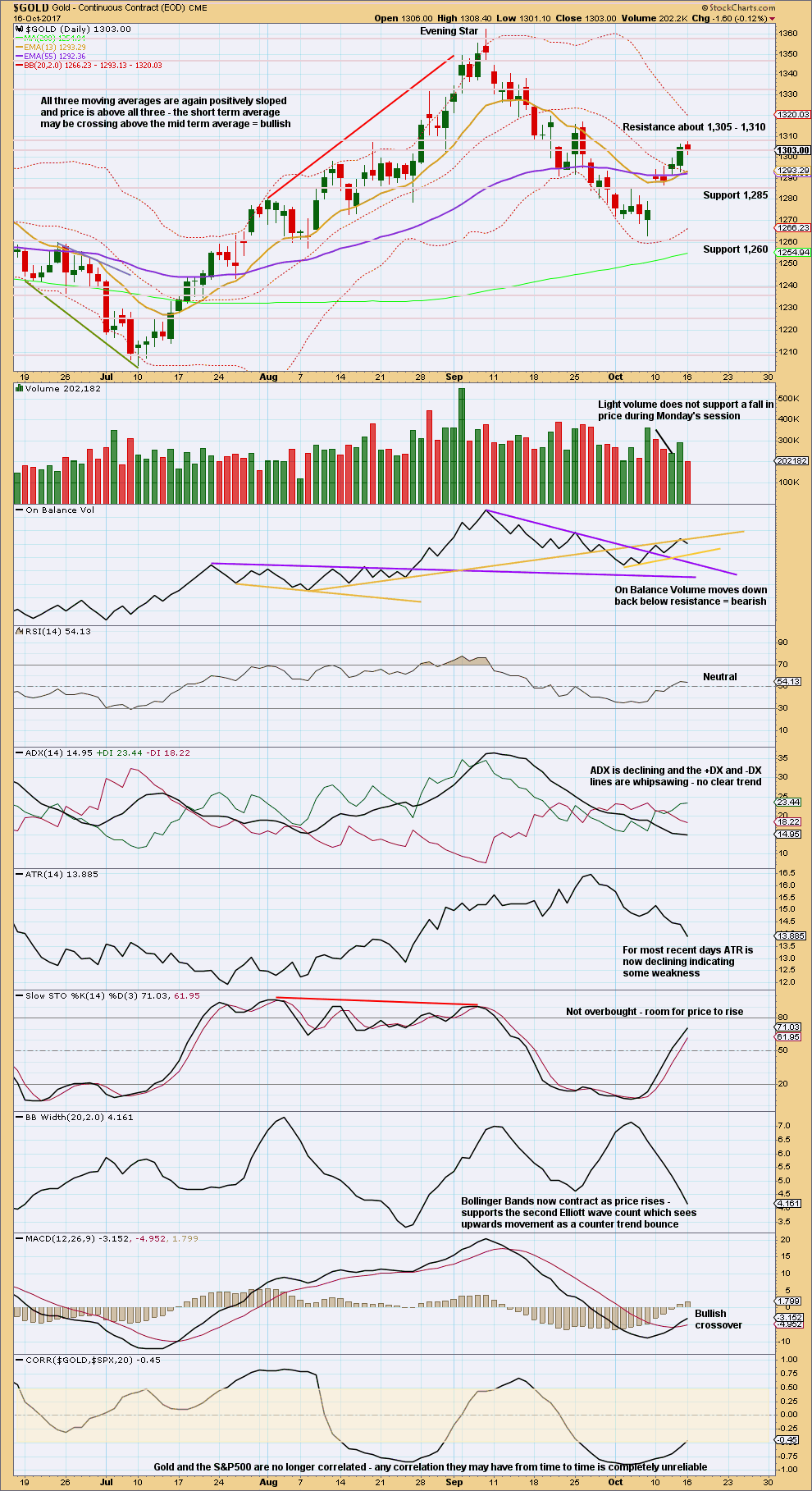
Click chart to enlarge. Chart courtesy of StockCharts.com.
Price has reacted strongly from resistance about 1,305 to 1,310. Downwards movement at the end of Monday’s session is not shown yet in StockCharts data, so it will probably be part of tomorrow’s candlestick.
Give weight to the bearish signal today from On Balance Volume. The last bullish signal is now negated as On Balance Volume turns down, and the yellow resistance line now needs to be slightly adjusted.
Support for the second Elliott wave count comes from contracting Bollinger Bands, declining ADX, declining ATR and weak volume. This does not look like the start of a convincing third wave up and so far it looks like a B wave.
GDX
DAILY CHART

Click chart to enlarge. Chart courtesy of StockCharts.com.
GDX today looks more clearly bearish than Gold: a bearish engulfing pattern is the strongest reversal pattern and here has support from volume. Give this signal weight.
ADX now agrees that GDX is in a downwards trend. This confirmation should add confidence today.
COPPER
DAILY CHART
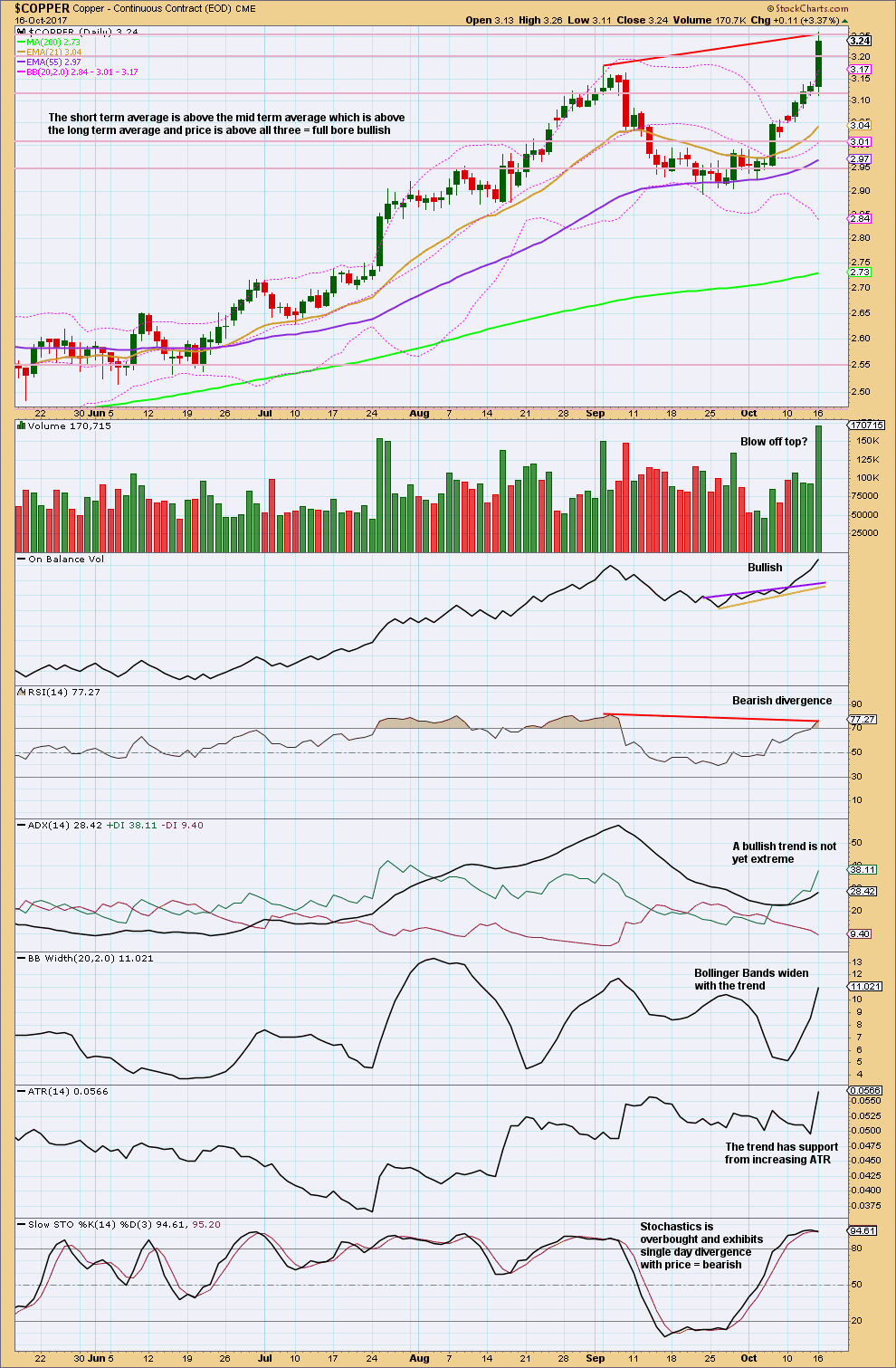
Click chart to enlarge. Chart courtesy of StockCharts.com.
Blow off tops are almost always followed by some downwards reaction, but are rarely the very end of a movement. They most often are followed by some consolidation or pullback before the final high is made.
Expect a red daily candlestick or doji for Tuesday for copper.
There is strong resistance here about 3.25. Look for support for any pullback about 3.12.
Published @ 08:07 p.m. EST.

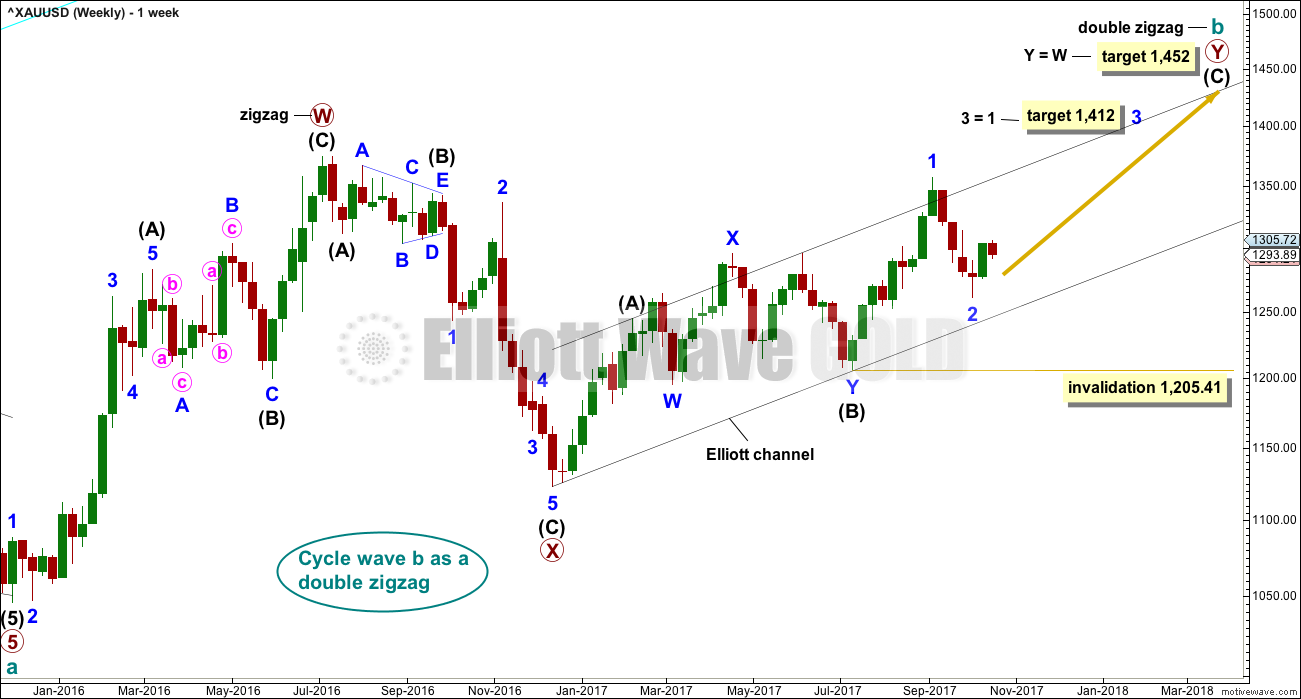
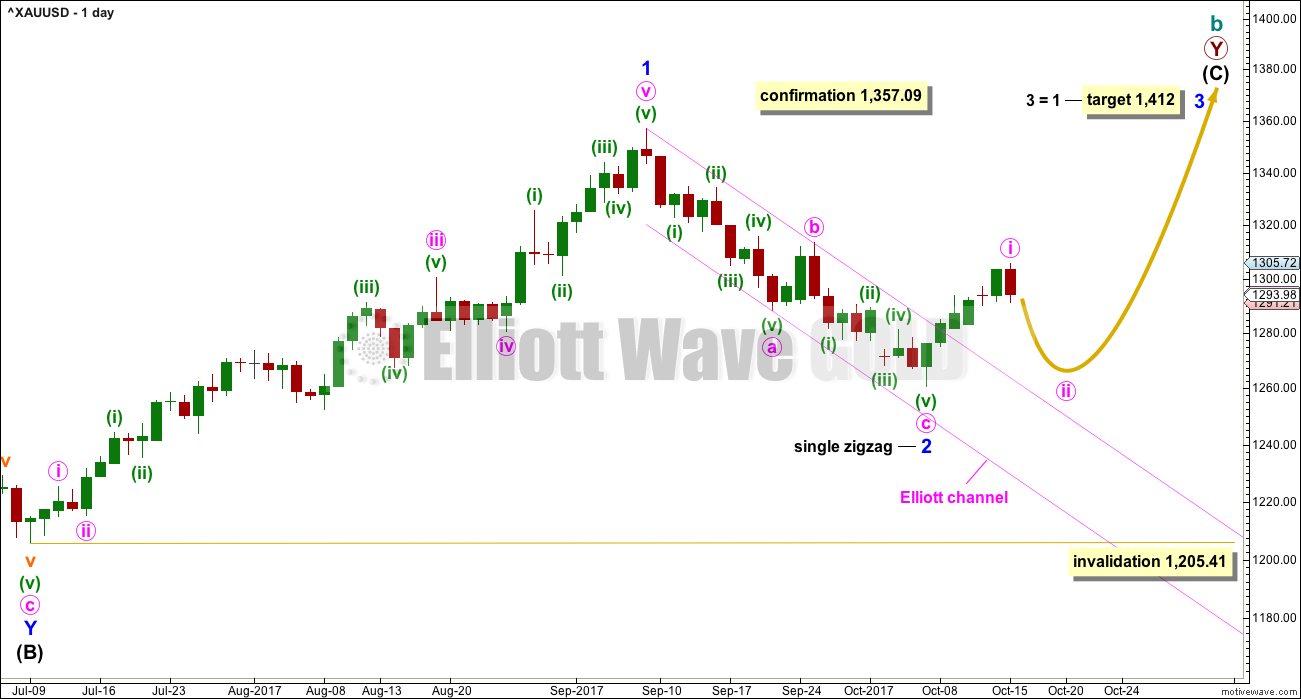
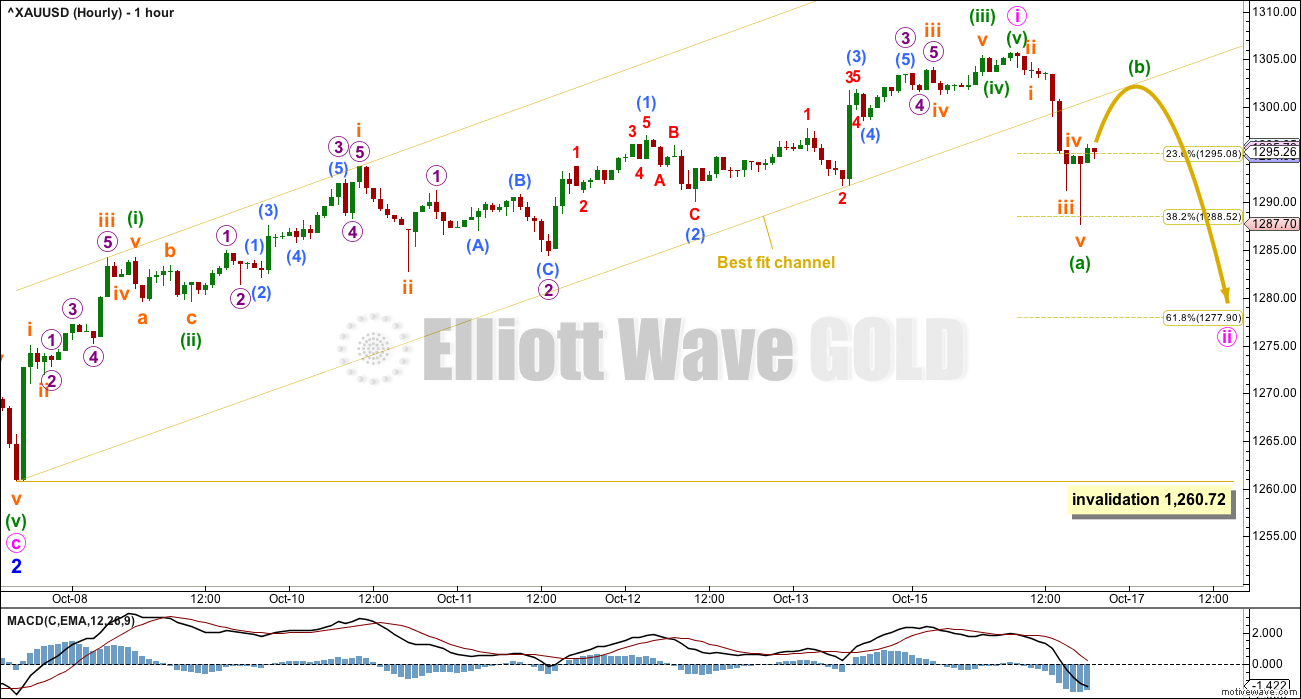
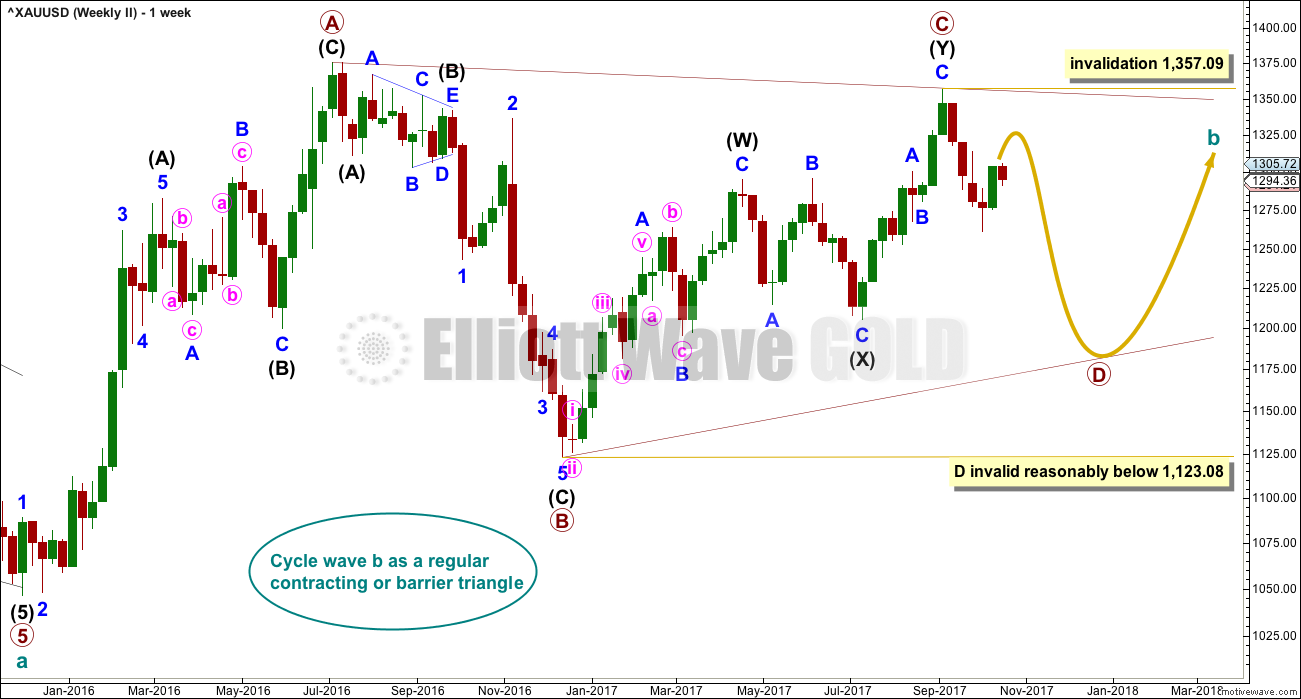
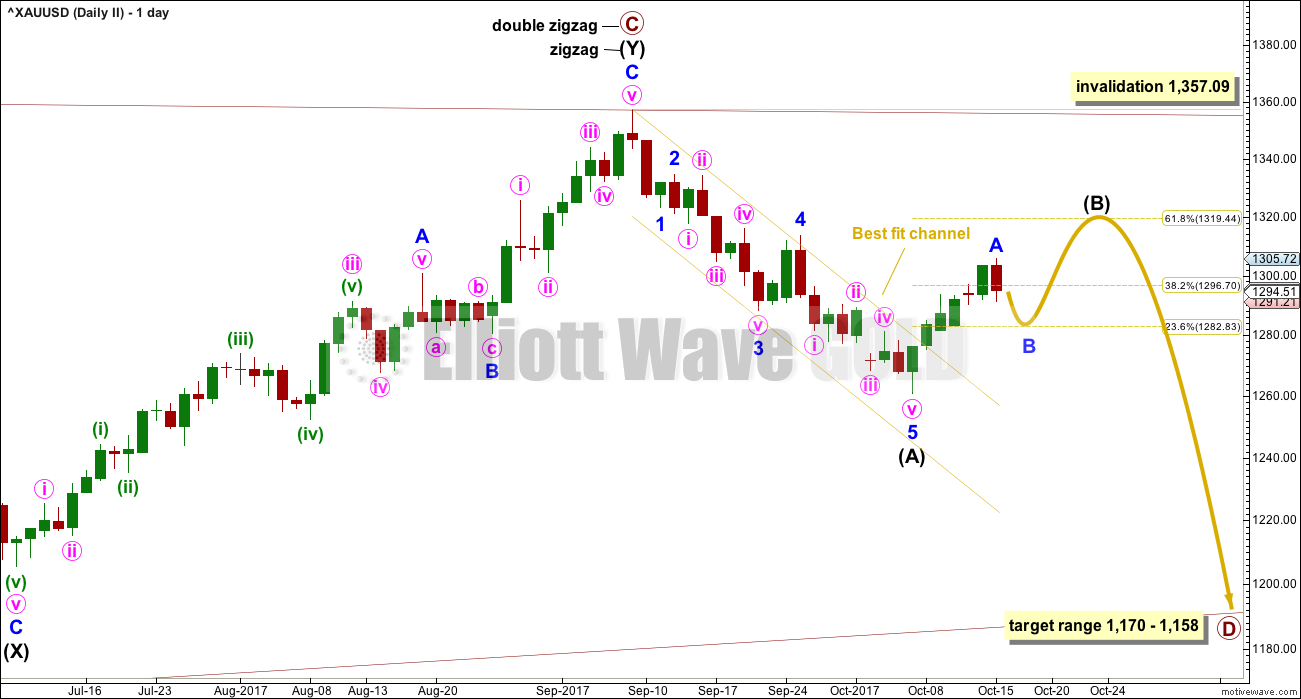
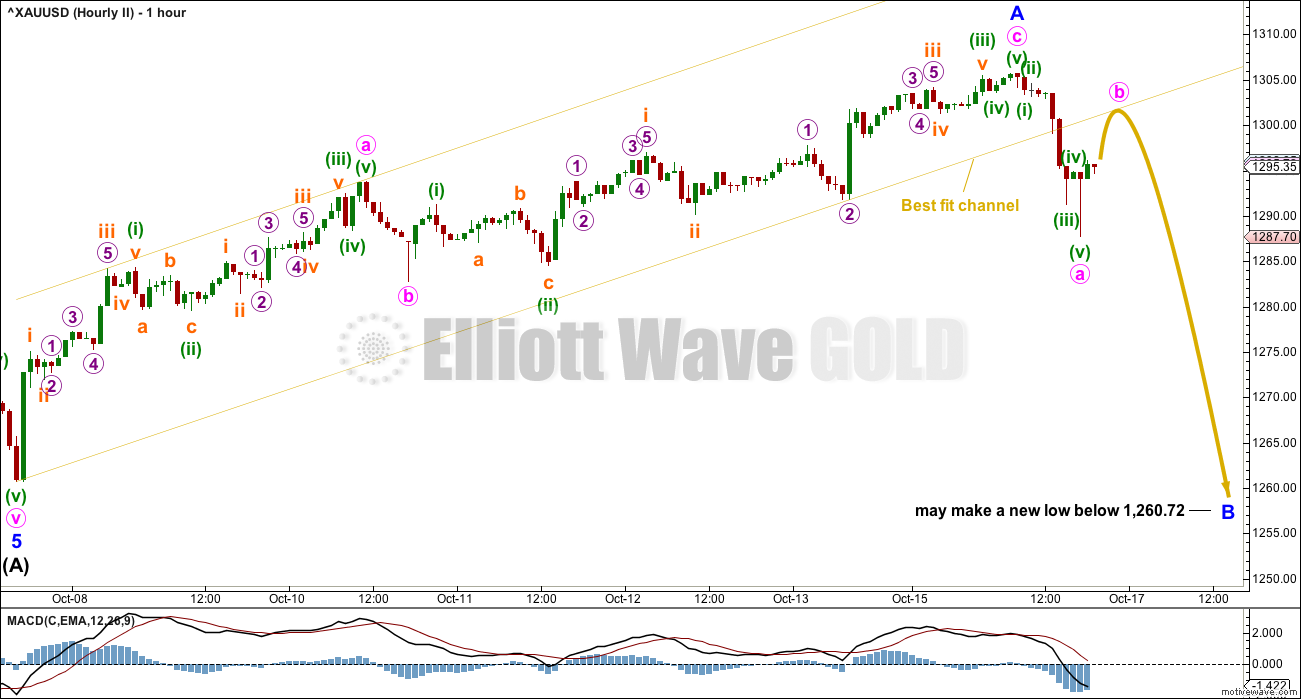
Good morning everybody 🙂
The pullback has finally arrived and is well underway. For good proportion it should continue now for at least another two days, and likely longer. There should be a B wave within the middle of it, and that may arrive shortly.
While my arrow expects a big bounce here please do not take that as gospel. It doesn’t have to look like this.
Because at this stage, with what looks like a three down now complete, the bounce could be a bounce within one of several scenarios:
1. A double zigzag for the pullback would see the bounce labelled minuette wave (x) which should be brief and shallow, much more brief than my arrow suggests.
2. A flat correction for the pullback would see the bounce required to be minimum 0.9 of the last wave down which (if it has begun now) is at 1,303.34. An expanded flat would see the bounce reach to 1,306.88 or above.
3. A triangle (which works for the second Elliott wave count but not the first) would see a bounce end about 1,300 to 1,302, an area of strong resistance. It could also make a new high as in a running triangle.
4. A combination would see a deep bounce labelled minuette wave (x) which has no minimum and may make a new high.
At this stage it is impossible to tell what corrective structure this may be. Only that it is very unlikely to be over, and it may be a typical choppy overlapping consolidation.
The future for copper looks solid with the growth of electric ⚡️ vehicles
http://www.gold-eagle.com/article/car-manufacturers-are-electrifying-copper-“-metal-future”
Thanks. Justifies buy on pullback.
I want my next car to be fully electric. But living in a small town in NZ I need a better range than they currently have.
We have charging stations popping up all over NZ. We even have one in my wee town Mangawhai. So it’s possible already if you plan it carefully to do a road trip in an EV. You just need lots of patience 🙂
Yep. It’s all about better battery technology. I’m sure they’ll figure it out in the coming years
The weakness in GDX relative to Gold today was disconcerting for the bullish count. For Minor 2 to hold, I’d like to see GDX price stay within the purple base channel drawn around Minor 1 & 2. This will require GDX to regain some relative strength vs. Gold.
The hourly count is reworked showing an expanded flat for Minute 2. While technically still possible, the expanding leading diagonal looks unlikely after todays deep retrace.
For the longs, caution is advised. If price breaks below the base channel (around 23.15), then it’s certainly possible that Minor wave 2 continues lower.
https://www.tradingview.com/x/gnVVHTRf/
Thank You Lara for Copper analysis 🙂
You’re welcome 🙂
Cycle analysis: https://www.edelsoninstitute.com/gold-silver/expect-gold-to-soar-again-when-investors-least-expect-it/?sc=WAV-E
Bottom line: We’re getting very close to the buying opportunity of a lifetime in precious metals. But we’re not there just yet. Later this week, in my upcoming issue of Real Wealth Report, I lay out the likely timing of the next uptrend in gold, and the best investment strategy to profit from it